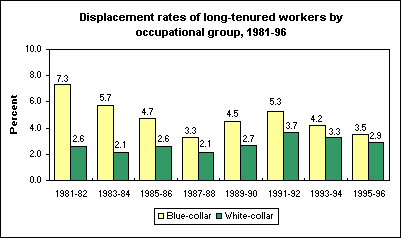An official website of the United States government
 United States Department of Labor
United States Department of Labor
In the mid-1990s, the displacement rate for blue-collar workers was much closer to the white-collar rate than it was a decade earlier.

[Chart data—TXT]
Displacement rates for blue-collar workers were 5.7 percent in 1983-84 and 4.7 percent in 1985-86. The corresponding rates for white-collar workers were 2.1 percent in 1983-84 and 2.6 percent in 1985-86, for an average difference of nearly three percentage points in the 1983-86 period.
In 1993-96, the rates for the two occupational groups were less than a percentage point apart on average. The displacement rates for blue-collar workers were 4.2 percent in 1993-94 and 3.5 percent in 1995-96, compared to rates for white-collar workers of 3.3 percent and 2.9 percent, respectively.
Worker displacement rates represent the likelihood of being displaced from a job. The rates cited here are for "long-tenured workers"—those who were in their jobs for 3 years or longer. Displaced workers lose their jobs because their plants or companies close down or move, their positions or shifts are abolished, or their employers do not have enough work for them to do.
These data are from supplements to the Current Population Survey. Find more information on displacement rates in "Worker displacement in the mid-1990s," by Steven Hipple, Monthly Labor Review, July 1999.
Bureau of Labor Statistics, U.S. Department of Labor, The Economics Daily, Displacement rates for blue-collar and white-collar workers more similar in recent years at https://www.bls.gov/opub/ted/1999/sept/wk3/art04.htm (visited May 08, 2024).

